From Floridata
by Steve Christman
Butia
capitata
Common
Names: jelly palm, pindo palm
Family:
Arecacea/Palmae, palm Family
Description
This beautiful feather palm has long pinnate leaves that
arch
and recurve towards the ground from atop a thick stout trunk. The trunk
can grow to 20 feet, but normally reaches 12-15 ft (3.7-4.6 m) with a
diameter of 1-1.5 ft (0.3-0.5 m). Typically, the old leaf stalks
persist for years, although specimens with clean trunks are not
uncommon. Leaves range from light green to bluish gray and grow 5 to 10
feet long. The leaf stems range from about 2-4 ft (0.6-1.2 m) in length
and have spines along both edges. The palm produces bright orange fruit
(often called pindo dates in the Deep South). These palms vary in form
from one individual to the next. Specimens raised in dry and/or
infertile soils tend to be smaller in stature with smaller leaves.
Light also affects the plant's form while those grown in full sun are
more compact.
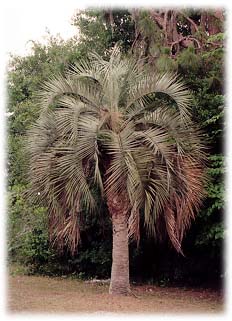 | | This mature pindo palm looks
especially attractive with its symmetrical form and a trunk that is
clear of old leaf stalks. |
The
apparent variability in specimens of B. capitata is also
due to the
fact that there are several other species in this genus that are very
similar in appearance. Palm enthusiasts in this country grow B. yatay
which resembles B.
capitata but grows taller and has a thicker trunk.
Other species include B.
eriospatha and B.
paraguayensis (which some
experts assert is a subspecies of B.
yatay). All of these hybridize
readily and it is suspected that many of the plants offered as B.
capitata may be hybrids. Butia can also be crossed with Syagrus
romanzoffiana (the queen palm) to produce the very
handsome mule palm.
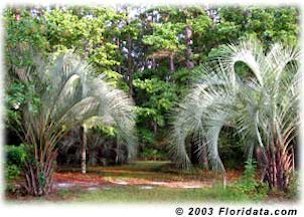 | | Jack planted these pindos from 1
gal containers 12 years ago. They have
grown to an overall height of 15 ft (4.6 m) in that time with only
minimal supplementary watering and an annual dose of fertilizer. |
Location
All
members of the Butia
species are native to the grasslands, dry
woodlands and savannahs of South America. Populations range across a
wide area of northern Argentina, southern Brazil, Paraguay and Uruguay.
The pindo is a popular landscape item in North Florida and throughout
the mild Gulf and Atlantic coastal regions of the southeastern United
States. It is also popular in northern California and similar warm
winter climates that are subject to occasional frosts.
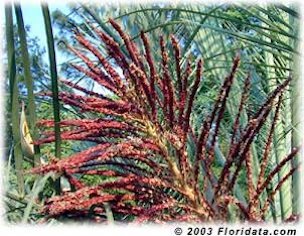 | | Pindo palm inflorescense |
This
pindo palm flower stalk (called an inflorescence) has recently emerged
from the tan woody case called a bract (the light pointed object to the
left).
Culture
Light:
Full sun to moderate shade (the fronds grow longer in shady situations,
giving the palm a more graceful aspect than those grown in full sun).
Moisture:
Prefers sandy, well drained soil but is adaptable and very drought
tolerant. Regular watering and feeding will produce a faster growing,
more attractive palm.
Hardiness:
USDA Zone 8-9. This is our hardiest
feather leafed palm. Specimens can be seen in North Carolina and I've
had reports of a Butia spotting in Washington D.C. On the west coast
the Pindo palm is grown as a novelty in warmer Zone 8 microclimates as
far north as British Columbia. This palm is not recommended for
subtropical and tropical climates.
Propagation: Seeds.
Young palms
are often found under palms that have been allowed to produce fruit. It
is not unusual to see offspring growing in the old leaf boots of a
mature tree.
Usage
Use
it as a lawn accent or in groupings. This palm is good for urban
plantings and can also be grown at the beach behind dunes or other
protection. Will adapt to container culture.
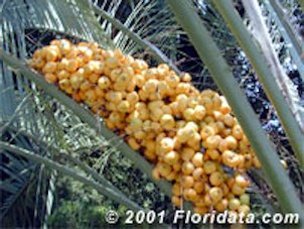 | | Pindo palm fruit |
This
is particularly nice bunch of pindo palm dates. The cluster is being
supported in an upright position by an adjacent leaf stem showing the
fruit off to full advantage. Typically the heavy clusters droop and
hang downward against the truck.
Features
This
is a beautiful
cold hardy palm that is very easy to grow. It is also drought tolerant,
inexpensive and readily available at nurseries and discount stores.
Like many palms, the pindo produces an elaborate flowering structure
called an inflorescence - the orange fruit forms on these structures
after the female flowers have been pollinated. In the deep south, a
jelly is made from these fruits. They have a terrific taste that starts
out like apple and tranforms to tart tropical flavors as it tantalizes
the tongue. Too bad the fruit has a large seed and stringy fibrous
flesh or I would eat them by the handful!
Warning
This
palm produces a
large quantity of fruit, which can be a nuisance, as ripening fruit
attracts wasps and other insects. Remove flower stalks to avoid messy
cleanups. The pindo fruits are rather tasty, but you probably don't
need 50 pounds of them!
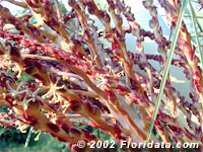 | 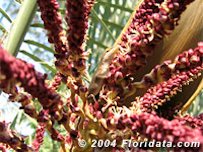 | The star-shaped flowers of the
pindo
palm look like underwater
creatures on a coral reef | Pindo palm (Butia spp.) flower
stalk |
|
|
Bibliography
Christman,
Steve. "Butia capitata."
Floridata,
no. 15, Published 27 Aug. 1997, Updated 29 May
1999, 24 June 2001, 3 Sept. 2001, 17 Aug. 2003, 30 May 2009, floridata.com/plant/15.
Accessed 21
Apr. 2014. Last update 22
Apr. 2014 LR. Last update 24 Mar. 2020 LR
|





